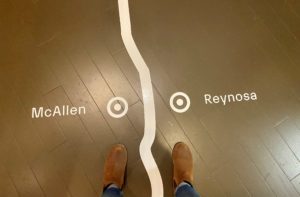Most people don’t ever get a chance to see the U.S.-Mexico border. Many of us may not think about the border at all — unless we know someone who has come to the border in hopes of a better life or merely to seek safety and basic human rights. Or when the news brings the border — and border narratives — to the forefront.
I often think about the border as a place that has points of intersection — and I have a combination of feelings about it. That’s in part because of what I read and see about the border and immigration in the news, in photos, and on social media.
My perceptions also stem from my work at the National Immigration Forum, where we’re striving for better solutions at the border. As just two examples, our Policy team recently published a paper called “What Makes a Border Secure? Building a Healthier Border Dialogue,” and earlier this year posted “42 Border Solutions That Are Not Title 42.”
A visit to the exhibit “The Wall/El Muro: What is a Border Wall?” offers even more insight. The exhibit, at the National Building Museum through July 3, 2023, is an opportunity to explore what the border is like and what the future of the border could be.

The exhibit homes in on data in an appealing and visual way, whether about border zones, migrant detention centers, numbers of border locations and offices or border-related deaths. It’s interactive and meaningful, each room adding layers of history. It tells multiple stories of journeys to the border and the reasons behind them. Some stories are of compassion and hope and opportunity. Others convey chaos, hopelessness, and oppression.
As you go from one room to the next, you might follow a long white painted line representing the geography and nuances of the border and its towns. I crossed from McAllen, Texas, to Reynosa, Mexico, in two seconds and snapped a photo, an example of a simplified simulation. The border is a lot more complex than that. But does it always have to be?

Sarah Leavitt, the exhibition’s curator, did a fantastic job putting together pieces of history that evoke empathy. It’s a feeling I wish more of us had when we think about migrants fleeing desperate circumstances — migrants who may only see hope as a possibility on the U.S. side of the border.
So, when will our federal policies reflect that empathy? Leavitt’s project proves to be a resource and education all in one. Its powerful photos, striking videos, English and Spanish explanations, audio testimonials and music, migrating butterflies painted on the wall and even an installation you can sit on that instantly transports you to childhood (trust me, you’ll understand when you go) make the exhibit a place to reflect on, recalibrate and rejuvenate our values.
There may not be a fully just border anytime soon, but changing hearts, minds, and narratives is the beginning to developing a just America that transcends time and borders. “The Wall/El Muro: What is a Border Wall?” starts us on that journey.

